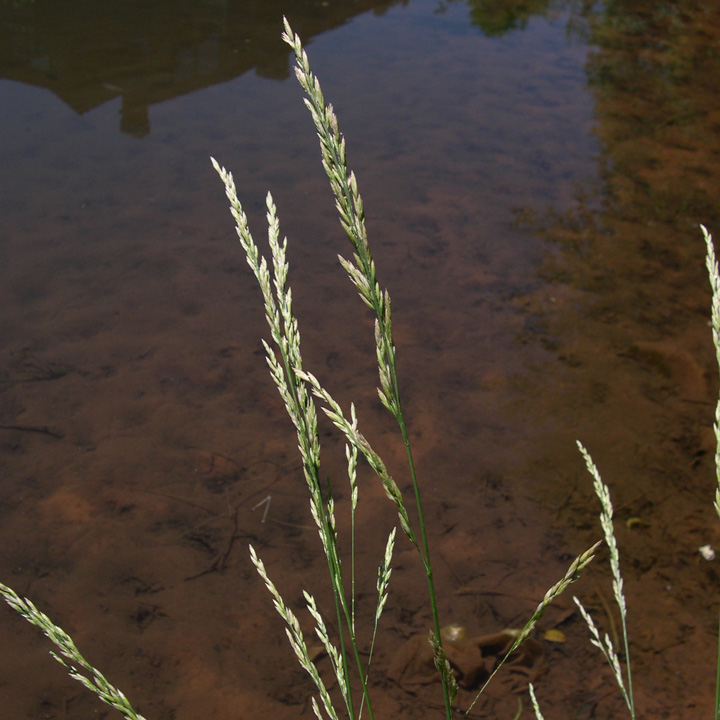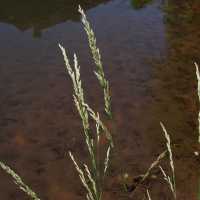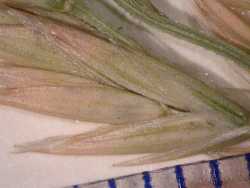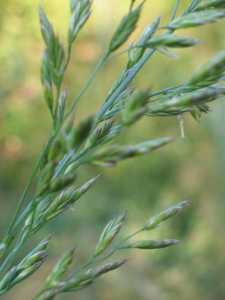Infrequent to frequent throughout the state. It is most frequent along roadsides and in waste places and has sparingly escaped to open woodland. Introduced as a forage plant. The Indiana farmers whom I have interrogated call it English bluegrass.
Common Name: tall fescue
Duration: Perennial
Nativity: Non-Native
Lifeform: Graminoid
General: Large tufted perennial with stems to 1.5 m, glabrous auricles that are falcate and clasping, sometimes with an undulating flange.
Vegetative: Blades flat 20-40 cm long, 4-18 mm wide, ligule membranous and glaucous, 1 mm.
Inflorescence: Spikelike panicle 8-50 cm long with 2 branches per node, erect to spreading with laterally compressed spikelets 8-13 mm long, 1.5-2.5 mm wide with 3-10 florets; disarticulation above the glumes and between the florets lower glumes 4-7 mm, equally wide, lanceolate to oblong, 3-7 veined, unawned or awned, awns to 18 mm, straight; upper glumes 4.5-7 mm; lemmas 5-9 mm, awns absent or to 4 mm, terminal or attached below the apices.
Ecology: Found in disturbed sites and along stream banks from 3,000-6,500 ft (914-1981 m); flowers April-September.
Distribution: Introduced to every continent and found throughout N. Amer., in every state in the US.
Notes: Distinguished by being a robust perennial bunchgrass with pronounced, ciliate auricles (top section of leaf sheath wrapping around the culm), where they are glabrous in F. pratensis; flat, wide leaves; and a condensed to semi-open panicle of spikelets with multiple florets, possessing rough-hairy lemmas.
Ethnobotany: Unknown
Etymology: Schedonorus is from Greek schedon, for near or nearby and nardos for spikenard, while phoenix is the Greek name for the date palm.
Editor: SBuckley 2010, FSCoburn 2015
Much like no. 1 [Festuca pratensis Huds.], often taller, to 2 m; old sheaths pale stramineous, only tardily disintegrating; blades coarse and thick, prominently ridge-veined above, 4-10 mm wide, with ciliate auricles; first node of the panicle with 2-3 branches, each with 5-15 spikelets, these mostly 3-6-fld; first glume (3-)4-6 mm, the second (4-)5-9 mm; lemmas 7-8.5+ mm, usually scabrous distally, the awn 0.3-2(-4) mm; 2n most often = 42, sometimes 28, 56, 63, 70. Native of Europe, widely planted in our range and elsewhere in the U.S., and readily escaping. (F. elatior, a rejected name)
Gleason, Henry A. & Cronquist, Arthur J. 1991. Manual of vascular plants of northeastern United States and adjacent Canada. lxxv + 910 pp.
©The New York Botanical Garden. All rights reserved. Used by permission.
Plant: Perennial grass to 1 m; panicle 15-30 cm, erect or nodding, with numerous branches, contracted; spikelets 6 to 8-flowered, 8-12 mm long; lemmas 7-10 mm long, rarely short-awned.














